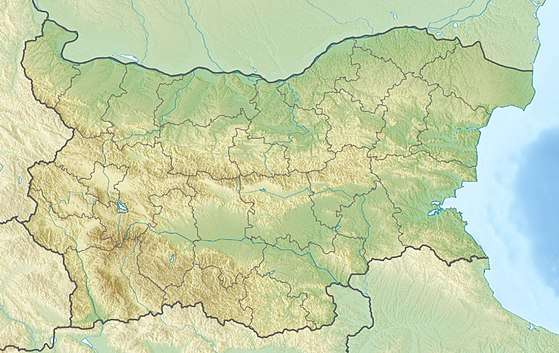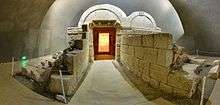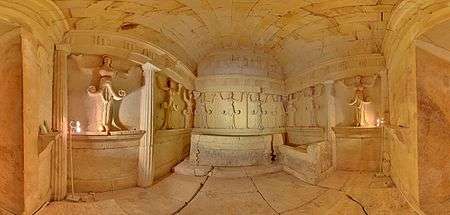Thracian Tomb of Sveshtari
| UNESCO World Heritage site | |
|---|---|
|
| |
| Location | Razgrad Province, Bulgaria |
| Criteria | Cultural: (i), (iii) |
| Reference | 359 |
| Inscription | 1985 (9th Session) |
| Area | 647.6 ha (2.500 sq mi) |
| Coordinates | 43°44′42″N 26°45′59″E / 43.744964°N 26.7663°ECoordinates: 43°44′42″N 26°45′59″E / 43.744964°N 26.7663°E |
 Location of Thracian Tomb of Sveshtari in Bulgaria | |
The Thracian Tomb of Sveshtari (Bulgarian: Свещарска гробница, Sveštarska grobnica) is 2.5 km southwest of the village of Sveshtari, Razgrad Province, which is 42 km northeast of Razgrad, in northeast Bulgaria.
General information
Discovered in 1982 in a mound, this 3rd century BC Getic tomb reflects the fundamental structural principles of Thracian cult buildings. The tomb's architectural decor is considered to be unique, with polychrome half-human, half-plant caryatids and painted murals. The ten female figures carved in high relief on the walls of the central chamber and the decorations of the lunette in its vault are the only examples of this type found so far in the Thracian lands. It is a remarkable reminder of the culture of the Getae, a Thracian people who were in contact with the Hellenistic and Hyperborean worlds, according to ancient geographers.
In 2012, archaeologists uncovered a significant treasure near the village. The treasure included a golden ring, 44 female figure depictions and 100 golden buttons, found in 150 tombs from the 4th century BC. It has been suggested that it is part of the site of the Getan city of Helis.[1]
 The Entrance to the Tomb Mound
The Entrance to the Tomb Mound The interior of the tomb
The interior of the tomb The Thracian Tomb of Sveshtari
The Thracian Tomb of Sveshtari
See also
References
- ↑ Delev, P. (2000). "Lysimachus, the Getae, and Archaeology". The Classical Quarterly, New Series. 50 (Vol. 50, No. 2): 384–401. doi:10.1093/cq/50.2.384. JSTOR 1558897.
Bibliography
- Alexander Fol, M. Čičikova, T. Ivanov, T. Teofilov: The Thracian Tomb near the Village of Sveshtari, Sofia 1986.
- Alexander Fol: "Die thrakische Orphik oder Zwei Wege zur Unsterblichkeit", in Die Thraker. Das goldene Reich des Orpheus, Ausstellung 23. Juli bis 28. November 2004, Kunst- und Ausstellungshalle der Bundesrepublik Deutschland. Philipp von Zabern, Mainz 2004, p. 177-186.
External links
| Wikimedia Commons has media related to Thracian Tomb of Sveshtari. |